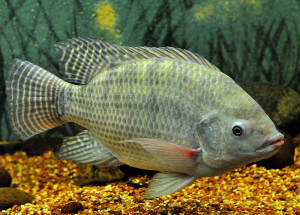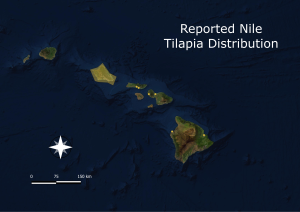Nile Tilapia
Nile Tilapia (Oreochromis niloticus)
Description:
- Distinctive vertical stripes on caudal fin and soft dorsal fin (Hasan and Tamam 2019; de Moor and Bruton 1988; Trewavas 1983)
- Red head coloration in breeding males (de Moor and Bruton 1988; Trewavas 1983)
- Can reach more than 5kg (FAO 2022)
Habitat:
- Fresh and brackish waters (CABI 2019)
- Prefers 31-36 ℃ (FAO 2022)
Impacts & Concern:
- High potential to invade and establish itself in almost all tropical regions (Zambrano et al. 2006) and adapt to non-native environments (Peterson et al. 2006)
- Can hybridize with aquaculture stock and be released into the wild (Costa-Pierce 2003) and has already hybrized in Hawaiʻi with Mozambique Tilapia (Oreochromis mossambicus) (Wu and Yang 2012) and blue tilapia (O. aureus) (Yamasaki et al. 2022)
- May negatively impact native fish (Martin et al. 2010) like ʻoʻopu alamoʻo (freshwater goby) (Mitchell et al. 2005)
- Reported as a nuisance catch when fishing for ‘ama‘ama or striped mullet (Mugil cephalus)
Introduction:
- May have been brought from Taiwan in 1980 for aquaculture (Wu and Yang 2012) and possibly later escaped (Szyper et al. 2000)
- Most introductions are a result of aquaculture (GISD 2015)
Distribution in Hawaii:*
- Kauai: Not documented
- Oʻahu: Present in aquaculture (Soto 2013; Wu and Yang 2012)
- Molokai: Kawela Stream, Kaunakakai Ditch (Yamasaki 2022)
- Lanai: Not documented
- Maui: Lahaina Stream, Kahului Stream (Yamasaki 2022)
- Big Island: ʻAlenaio Stream (Yamasaki 2022), Hilo (Wu and Yang 2012)
* The species is also present in the state in aquaculture sites indicated by the polygon
Regulations:
- Restricted for private and commercial use including research, zoological parks, aquaculture production or non-profit research (§4-71-6.5)
- Does not include individual possession of an animal as a pet
Related Management Projects:
- 2020 fishing tournament in Hilo caught 75 lbs of tilapia and 85 lbs of other non-native fish species.
- ‘Ama ‘ama fishermen are encouraged to consume Nile tilapia by catch
News:
- Hawaii island man turns in ‘monster’ pet Nile tilapia to state DLNR
- Hawaii Board of Agriculture Approves Tilapia Rule Change
References:
- CABI (2019). Oreochromis niloticus (Nile tilapia) In: Invasive Species Compendium [Data set]. CAB International. https://www.cabi.org/isc/datasheet/72086
- Costa-Pierce, B.A. (2003) Rapid evolution of an established feral tilapia (Oreochromis spp.): the need to incorporate invasion science into regulatory structures. Biological Invasions, 5, 71–84. https://doi.org/10.1023/A:1024094606326
- de Moor, I.J., & M.N. Bruton. (1988). Atlas of alien and translocated indigenous aquatic animals in southern Africa. South African National Scientific Programmes Report 144. Foundation for Research Development and Council for Scientific and Industrial Research.
- Hasan, V. & Tamam M.B. (2019). First record of the invasive Nile Tilapia, Oreochromis niloticus (Linnaeus, 1758) (Perciformes, Cichlidae), on Bawean Island, Indonesia. Check List, 15(1), 225–227. https://doi.org/10.15560/15.1.225
- Martin C.W., Valentine M.M., & Valentine J.F. (2010). Competitive Interactions between Invasive Nile Tilapia and Native Fish: The Potential for Altered Trophic Exchange and Modification of Food Webs. PLOS ONE, 5(12), e14395. https://doi.org/10.1371/journal.pone.0014395
- Mitchell, C., Ogura C., Meadows D.W., Kane A., Strommer L., Fretz S., Leonard D., & McClung A. (2005). Hawaii’s Comprehensive Wildlife Conservation Strategy. Department of Land and Natural Resources. Honolulu, Hawai‘i. 722 pp.
- Peterson, M., Slack, W., Grammer, G., Finley, J., Woodley, C., & Partyka, M. (2006). Foraging in Non-Native Environments: Comparison of Nile Tilapia and Three Co-Occurring Native Centrarchids in Invaded Coastal Mississippi Watersheds. Environmental Biology of Fishes, 76, 283-301. 10.1007/s10641-006-9033-4.
- Randall, J. E. (1987). Introductions of marine fishes to the Hawaiian Islands. Bulletin of Marine Science, 41(2), 490-502.
- Soto, E., McGovern-Hopkins, K., Klinger-Bowen, R., Fox, B., Brock, J., Antonio, N., van der Waal, Z., Rushton, S., Mill, A., & Tamaru, Clyde. (2013). Prevalence of Francisella noatunensis subsp. orientalis in Cultured Tilapia on the Island of Oahu, Hawaii. Journal of aquatic animal health, 25, 104-9. 10.1080/08997659.2013.781554.
- Szyper, J.P., Hopkins, K.D., Malchow, W., & Okamura, W. Y. (2000). History and Prospects of Tilapia Stocks in Hawaii, U.S.A. In Tilapia Culture in the 21st Century–Proceedings from the Fifth International Symposium on Tilapia Aquaculture, Rio de Janeiro, Brazil.
- Trewavas, E. (1983). Tilapiine Fishes of the genera Sarotherodon, Oreochromis, and Danakilia. The Dorset Press. https://doi.org/10.5962/bhl.title.123198
- Wu L., & Yang J. (2012). Identifications of Captive and Wild Tilapia Species Existing in Hawaii by Mitochondrial DNA Control Region Sequence. PLOS ONE, 7(12), e51731. https://doi.org/10.1371/journal.pone.0051731
- Yamasaki L.S., Iwai T.,Klinger-Bowen R. C., Weese D.A., Fowler C.E., Yacoub J.L., & Wong M.A. (2022). Identification of Nile tilapia (Oreochromis niloticus) and its hybrids in natural environments in Hawaii. Aquaculture, 550, e737805. https://doi.org/10.1016/j.aquaculture.2021.737805
- Zambrano, L., Martínez-Meyer, E., Menezes, N., & Peterson, A. (2006). Invasive potential of common carp (*Cyprinus carpio*) and Nile tilapia (*Oreochromis niloticus*) in American freshwater systems. Canadian Journal of Fisheries and Aquatic Sciences, 63, 10.1139/F06-088.

